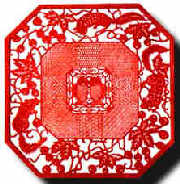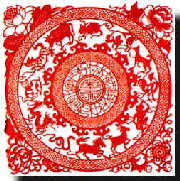
Also known as Chinese exquisite paper-cut, Chinese exquisite paper-carving is an exotic flower in the world of Chinese folk art, having its origin in the Yu Family living in front of the Xiangyang Temple. Paper-carving artworks were made of rice paper or Maobian paper (a kind of pale-yellow writing paper made from bamboo pulp) by handicraftsman at that time. In 1998, Leqing exquisite paper-carving works were honored as the "Only One in China" at the National Exposition of Traditional Arts, with several of its masterpieces, such as the "Panda", being collected by the Chinese Art Gallery.
The art of exquisite paper carving has a long history in Leqing, and reportedly has some connections with the "Dragon-boat lantern". In the ancient times, during the Spring Festival, nearly every household in Leqing would make a "Dragon-boat lantern", within which drama figures made of silk were often placed. Paper-carving works of various designs and shapes were pasted onto both the inner and outer sides of the lanterns. Later, Leqing women used these paper carvings as embroidery maps to design pattern on hats, shoes or bellybands. Therefore, paper carving is also called "clipping flower".

In paper carving, rather than clipping the paper, the craftsperson usually carves it, thus giving the artwork bright lines and rich expression. The main tools used for paper carving are the graver, whose cutting edge is only 0.35 millimeter thick, and the lacquer tray, which is used to lay under the paper as the craftsperson hollows out the paper and clears the unnecessary part. The paper carvings usually are adorned with beautiful design patterns and exquisite workmanship. Some skillful artists can cut more than 150 holes a paper per square centimeter, and some can carve out flowers, birds, figures and landscapes with each thin line only one millimeter wide. Within a one-centimeter-wide paper, the artists can do 22 carvings in which there is hardly half a millimeter between each other carving.

One of China's most famous paper-carving artists, Chen Zhaofen, can carve 50 thin lines on a paper of only one square millimeter, with each of these lines being connected closely, which is rather a phenomenon. According to Zhang Shuxian, vice president of China's Paper-cut Association, to carve such delicate lines depends more on feeling rather than the eyes. "Thinness and delicacy", the most outstanding features of Chinese exquisite paper carving, cannot be found in paper-cut works in any other country.
After the founding of new China in 1949, while inheriting the traditions, Chinese exquisite paper carving entered a new era with creations in design patterns. Some paper-carving works have been displayed at home and abroad, gaining widespread fame. However, as fewer people are willing to learn this painstaking folk art these days, it is now close to extinction.
Arthor: Jessie










